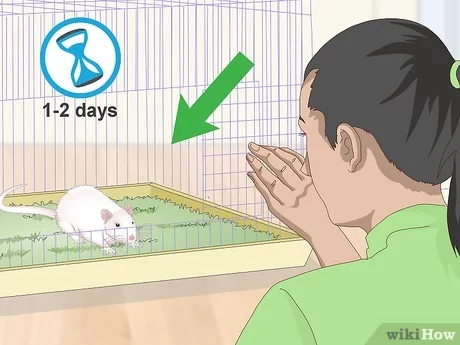
How to train a rat to your hands: step by step instructions

The hobby for domestic decorative rats has been going on for more than a dozen years. Many sincerely mentally attached to their pets, popularizing this kind of pets. The number of fans of cute rats is growing, but newcomers to this business often have the question: “How will a rat get used to hands so that tactile contact gives both real pleasure?”
Contents
What is a decorative rat?
The Latin name for the ornamental animal is Rattus norvegicus forma domestica, which means “domesticated form of the gray rat.” That is, it is an ordinary pasyuk (Rattus norvegicus), which has gone from a basement ship thief to a domesticated pet.
Domestication is a long process of taming, keeping, selecting and breeding wild animals in artificial conditions created by man.

Such directed selection led to many changes in the behavior and instincts of the animal, adapting it to living not just next to a person, but making it viable only at home.
Without human care, a decorative rat simply will not survive, because a person, in the process of domestication, has deliberately deprived it of many of the survival mechanisms that the common gray pasyuk rat uses.
This includes not only changes in the protective color, coat structure, ear shape and lifestyle (an ordinary rat is active at dusk and at night), but also the absence of fear – neophobia, which in the wild quickly leads to a sad end.
But how to explain to a tailed pet that you – his owner – only wish him well?!
How to train a rat
The rat is a very intelligent animal, effortlessly navigating in space, with unusually sensitive hearing and smell, dexterous and cunning, playful and attentive, sociable and affectionate, easily trained, and also affectionately affectionate to the owner.
But in order for the rat-owner connection to be firmly established, it is necessary to tame the decorative rat – to accustom it to its smell and to its hands.
Experienced “rat breeders” advise after acquiring a pet to allow him to get to know your smells to his heart’s content.
The rat cannot perceive your appearance – it does not see your face as a whole, and indeed its vision is far from perfect.
Taming a rat to the smell and “look” of the owner is a simple matter – this is the first stage of accustoming to hands.
Instructions for taming a rat
Taming is carried out in 4 stages:
First Stage
For the first 2-3 days, do not disturb the rat in its cage, do not try to pull it out by force.

Put your item in the cage – an unwashed T-shirt (a piece, of course) or socks, let this smell be associated with a new home and with you.
Keep the cage somewhere near you – on the table, by the sofa, next to the computer and on the kitchen table.
Give the new tenant a new name!
Whatever you do, do not forget to affectionately address the rat by name, from time to time squeezing some “yummy” through the bars of the cage: a piece of cucumber, dried banana, fish, nut, pumpkin seed, etc.
During this time, the beauty or the little rat will get used to the fact that something big, with a pleasant voice (rats are very musical!) And with a supply of various goodies, is not going to cause harm. And yes, it smells pretty good too!
Step two
Here you will need a T-shirt and a long sleeve trowel.
We put on a T-shirt, tuck it into a belt, fasten the trowel with a zipper, carefully take the rat out of the cage under the belly and put it in our bosom.
Attention! A rat that has not previously dealt with a person or has had a sad experience of communicating with a bad person is afraid of hands!
Just in case, get the rat with your hand in a thick (preferably leather) glove.
You can do household chores without paying attention to the journey of the animal through your body. And be sure to talk to him!
If a traveler sticks his muzzle out of a collar or sleeve, call him by name, give him a prepared tidbit and try to caress him.
The first time, perhaps, everything will end with a bitten finger, but you should not give up trying – in the end, the rat will appreciate your patience.
We stop the supply of “sweets” through the bars of the cage.
Stage three
After the rat has begun to feel at ease under your clothes, let it run around the sofa or table, while you yourself stay close.
Once you get used to the safety of your body, it will not be difficult to tame a baby rat or an adult rat to return to you, especially if the animal will receive a treat every time it returns to your chest or legs.
If the curious animal nevertheless escaped, then it is not necessary to move the furniture in search of it. Leave an open cage on the floor with a portion of food, and the fugitive will return to a familiar house within a day.
Stage four
You can accustom a rat to hands using the same method of treats, but now it will be impossible to drag a treat into a cage – sour cream, for example. First, hold a saucer of sour cream in your hands at the open door, gently luring the animal. When he learns to eat from your hands, spread sour cream on your fingers and stick your open palm inside the cage. After a couple of attempts to drag your fingers into the house, the rat will understand that she can get food only by licking your hand.
When this lesson is learned, complicate the task: bring your open palm to the door, and dip the finger (fingers) of the other hand in sour cream and hold it over the open palm so that the animal is forced to sit on the palm if it wants to get to the sour cream. Don’t forget to say something nice!
After a while, a tame rat will willingly go into the palm of your hand, knowing that this is a safe business and at the same time you can also profit from delicious treats.
How fast is the taming process
Rats have bright individual character traits. For one, 2 weeks is enough, for the other – 2 months. Time, patience, constancy – these are 3 whales of success in order to tame a domestic rat and teach it to be calm about your hands.
There are individuals who do not like to sit on the handles and be tortured by squeezing. There are those who are ready to take stroking and scratching for hours.
Each individual has its own character, temperament and addictions – this must also be taken into account.
It is necessary to tame the animal to the hands so that the rat understands that your hands are not dangerous – they can be trusted, and you could perform some manipulations both with the animal itself and with its cage.
Getting used to hands is the key to your own “safety”, first of all!
Video: how to tame a rat to your hands
How to tame a domestic rat
3.8 (75.32%) 47 votes







